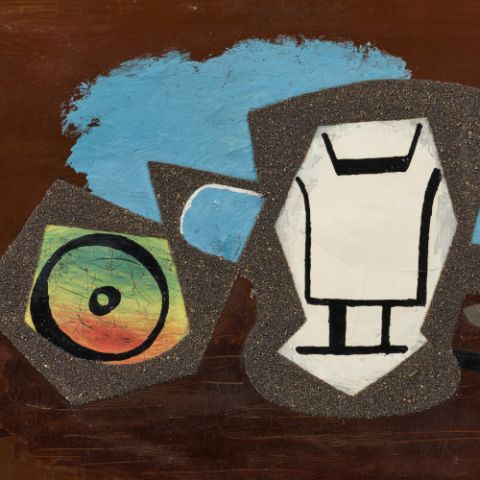
Lot 5 | Kurt Schwitters | Untitled (Fiskutsalgs Eftf.)
1887 Hannover - 1948 Ambleside
Title: Untitled (Fiskutsalgs Eftf.).
Subtitle: Merzzeichnung.
Date: 1936/39.
Technique: Paper collage on painted card.
Measurement: 17 x 13,5cm, mounted on original pad: 19,5 x 26,5cm.
Notation: Signed lower left on the pad: Kurt Schwitters. Inscribed by a hand other than that of the artist verso: preliminary oeuvre catal. No. 1936/39, 582.
Frame/Pedestal: Framed.
Provenance:
- Ernst Schwitters, Lysaker (1948-1988 through inheritance from the artist)
- Klipstein & Kornfeld, 1956
- Private collection
- Galerie Papbst, Munich (stamp)
- Galerie Gmurzynska, Cologne 1989 (label)
- Galerie Remmerth & Barth, Düsseldorf 1989
- Private collection Hesse
Exhibitions:
- Galerie Gmurzynska bei der FIAC, Grand Palais, Paris 1984
- Galerie Gmurzynska, Cologne 1984-1985
- Galerie Michael Pabst, Munich 1988-1989
Literature:
- Orchard, Karin/Schulz, Isabel: Kurt Schwitters - Catalogue Raisonné, vol. 2 1923-1936,
Ostfildern-Ruit 2003, cat. rais. no. 2080, ill.
- Exhib. cat. Nouvelles Acquisitions 1984/Neuerwerbungen, Galerie Gmurzynska, Cologne; FIAC, Grand Palais, Paris 1984, p. 67, cat. no. p.67, ill.
- Exhib. cat. Die Collage, Galerie Michael Pabst, Munich 1988, cat. no. 35, ill. 35
- Nestegard, Jutta: Kurt Schwitters i Norge, unpublished. Typoscript, master's thesis, Varen 1993, ill. 92
- Stadtmüller, Klaus (ed.): Schwitters in Norwegen. Arbeiten, Dokumente, Ansichten, Hanover 1997, p. 50, ill.
- The collages are among the artist's most sought-after works on the international art market
- Humorous example from the series of Merz drawings due to the arrangement of the photographic pictorial elements
- Interesting provenance
Art can embrace everything
Kurt Schwitters (1887-1948) is a German artist, poet and writer who is known for his contributions to the Dada movement and the Merz art form he developed. He is still considered one of the most versatile and innovative artists of classical modernism. After studying art in the traditional way in Dresden, he turned to the avant-garde after the First World War and began creating unique collages and assemblages from everyday objects in 1919. Schwitters was firmly convinced that art could encompass anything.
The paper collage shown here is one of Kurt Schwitters' famous Merz drawings and was created in 1936/39. During the 1930s, he spent long periods in Paris, Switzerland, the Netherlands and, above all, repeatedly in Scandinavia, especially in Norway, where he settled permanently at the beginning of January 1937, finally leaving Germany due to the political events there. Since the Nazis' rise to power, his art had been considered “degenerate”. The war and the occupation of Norway by the German army finally prompted him to move to England, where he lived and worked from April 1940 until his death in 1948.
In his new homeland
With this work, and particularly with the found objects incorporated into it, Schwitters demonstrates life in his new home in Norway and processes the spirit of his time. ‘Kurt Schwitters addresses his own civilisation by working with its remnants,’ says Isabel Schulz (Schulz, Isabell “Art is far too precious to me to be misused as a tool”. Kurt Schwitters and politics, in: exhib. cat. Schwitters Arp, Kunstmuseum Basel 2004, p. 200). His examination of current political issues is clearly recognisable, even if only subtly hinted at.
In his paper collage, the passionate collector Kurt Schwitters combines various photographic reproductions, paper cut-outs and a Norwegian bill. With playful charm, the individual relics are transformed into a fantastic pictorial puzzle. What particularly catches the eye is half of an unidentifiable male torso. The person stares straight at the viewer with a frightened expression. Another man can be seen in profile, mainly his ear, with no clues as to his identity. A photograph of onlookers, photographers and possibly journalists in the lower left half of the picture suggests an unspecified, possibly political event that is worth observing. The artist also includes a section of a Norwegian bill from a fishmonger that provides information about his place of residence at the time. Schwitters takes the individual found objects out of their original context and transforms them into a new composition with a new meaning. In this work, he is not only concerned with playing with forms, but rather with visualising the fractures and divisions of post-war society.
Schwitters used his art as a kind of diary of everyday life, in which he intensively combined contradictions and similarities. His collages not only tell a single story, but rather represent a collection of events that took on a comprehensive, holistic form in Schwitters' unique Merz pictures until his death.
+49 221 92 58 62 304
Print this lot | Recommend lot |
Conditions of this Lot
32% buyer’s premium on the hammer price
Kurt Schwitters Germany Dadaism Surrealism 19th Century Paintings Modern Art 1930s Framed Writing Collage Paper collage





